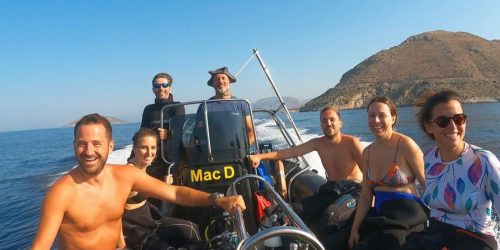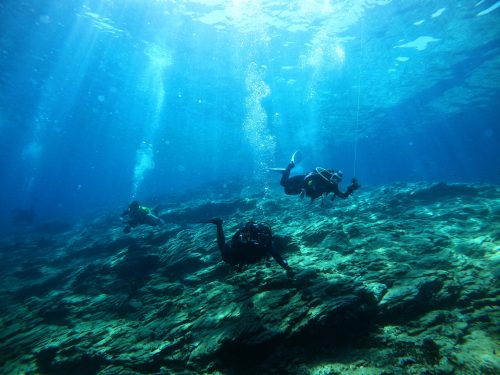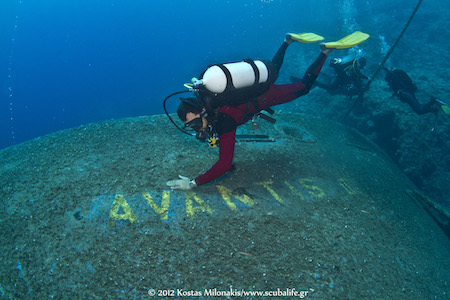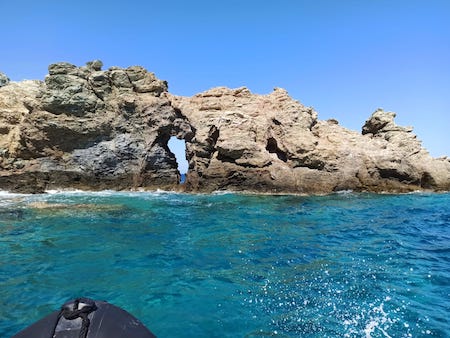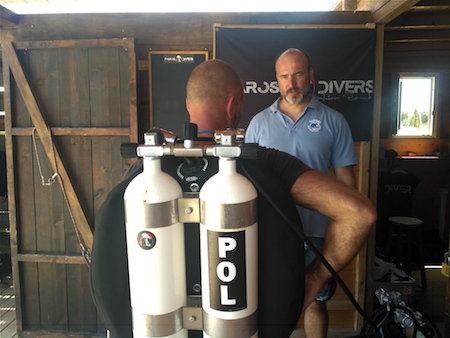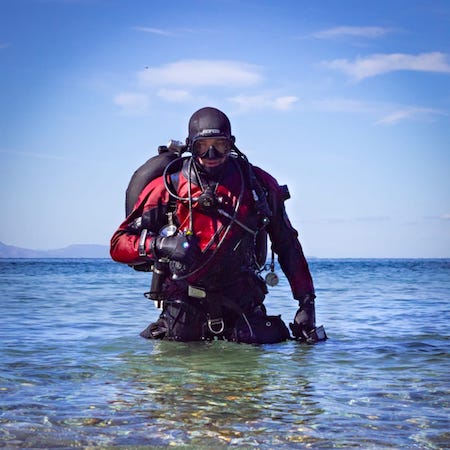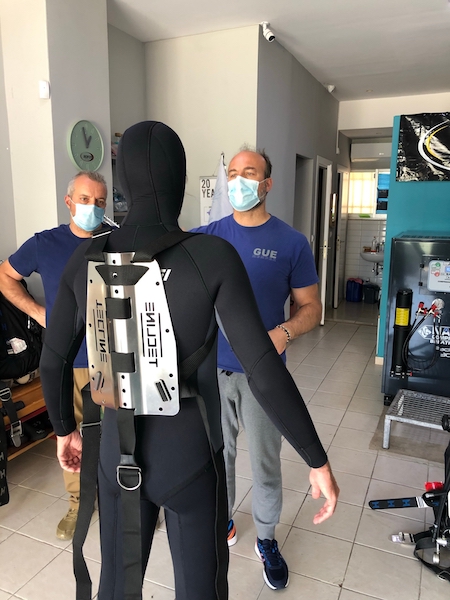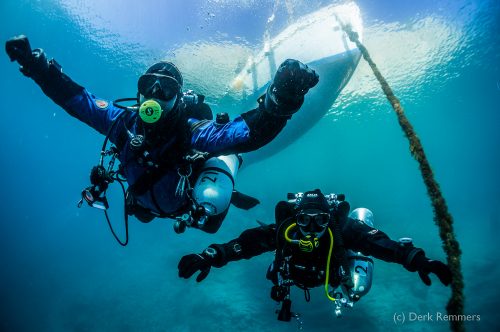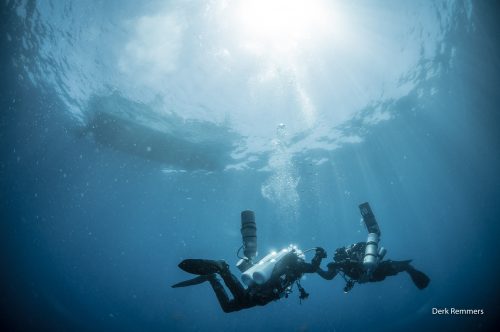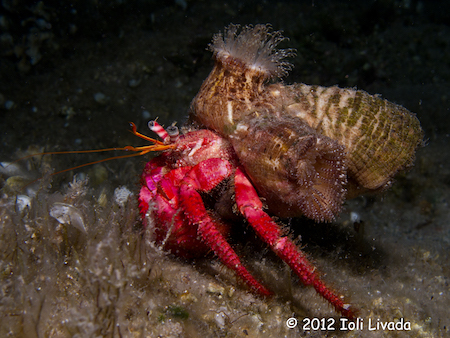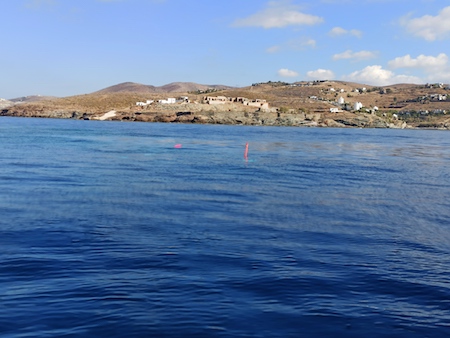-
Join us for the most fascinating diving around Athens and the Attica Peninsula in Greece. Conveniently located within 10 miles of our base, there are over 20 dive sites right on our doorstep. This is the best diving in Attica and our premier destination. From shipwrecks to car cemeteries to caverns and everything in between, there is a new dive spot on every corner. We’ll explore uninhabited islands, rocky outcrops and find ancient relics both in and out of the water. Beautiful underwater topography too including canyons, cracks, caverns, archways and sandy passageways.Let us show you around our hood – we’re right in the heart of wreck diving in Greece!
-
For a wilder, more remote experience, join us for a diving trip to Makronissos. This historic, long, and rugged island stretches down the west side of the Attica Peninsula and has numerous coves to explore. A bit further, this is one of our longer 2-tank dive trips and gives you a feeling of adventure! Dive sites around Makronissos include reefs, plane wrecks, shipwrecks, and small canyons. Exploring on land is possible too. Known as the Greek Alcatraz, Makronissos was an exile island during the Greek Civil war and there are plenty of sights to see. We know all the best ones!
-
Our day trip diving around Aegina Island in the Saronic Gulf offers excellent diving, close to Athens. A charming, easygoing, and popular destination, the diving around Aegina is superb. There is a triangle of wreck, volcanic and rocky dive sites between the mainland, rocky islets, and this verdant island. The top dive here is AVANTIS III, a sunken cargo ship, good for all recreational and technical diving levels. She crashed into the Doroussa islet in 2004 and is in excellent condition. The site is well-sheltered from the wind too. Aegina is a verdant, sheltered island with romantic streets and towns that exude simple charm. After a hard day’s diving, we usually stop in Perdika for a delicious traditional Greek meal before heading back to base.
-
Join us for the most fascinating diving around Athens and the Attica Peninsula in Greece. Conveniently located within 10 miles of our base, there are over 20 dive sites right on our doorstep. This is the best diving in Attica and our premier destination. From shipwrecks to car cemeteries to caverns and everything in between, there is a new dive spot on every corner. We’ll explore uninhabited islands, rocky outcrops and find ancient relics both in and out of the water. Beautiful underwater topography too including canyons, cracks, caverns, archways and sandy passageways.Let us show you around our hood – we’re right in the heart of wreck diving in Greece!
-
For a wilder, more remote experience, join us for a diving trip to Makronissos. This historic, long, and rugged island stretches down the west side of the Attica Peninsula and has numerous coves to explore. A bit further, this is one of our longer 2-tank dive trips and gives you a feeling of adventure! Dive sites around Makronissos include reefs, plane wrecks, shipwrecks, and small canyons. Exploring on land is possible too. Known as the Greek Alcatraz, Makronissos was an exile island during the Greek Civil war and there are plenty of sights to see. We know all the best ones!
-
The GUE Fundamentals course is by far GUE’s most popular program. The Basic Fundamentals course is designed for divers who seek to enhance their foundational diving skills, which are required for sound diving practices.
Some divers use the GUE Fundamentals program as a way to improve on the less-than-optimal training they have received during traditional fast-track entry-level courses. Others see the course as a ticket to participate in GUE projects and activities. Everybody will benefit, regardless of their current level of certification or experience. Graduating this course with a pass is something to be proud of, as the quality of a GUE Fundamentals diver is recognized all over the diving world. For many non-GUE divers, the Fundamentals program is an “aha!” moment where everything falls into place. The standardized equipment configuration and standardized procedures are only a small part of the big picture. Realizing how a team-oriented approach can free up resources and increase situational awareness that can be used to maximize safety, efficiency, and fun is often a life-changing moment for Fundamentals students, and they walk away from the course with a completely new approach to diving. -
If your diving activities have extended bottom times or you would like to dive in colder water, you will need proper thermal protection. GUE's Drysuit Diver course prepares divers for dry suit diving using proper equipment and techniques.
-
One of the most competent open water courses in the industry. If you want to start good, you go full throttle! Use of Nitrox, max 21m, SMB deployment, basic navigation, basic rescue skills.
GUE’s Recreational Diver Level 1 course is designed to provide non-divers with sufficient knowledge, skill, and experience to dive within the limits of similarly qualified scuba divers. Qualified GUE Recreational Diver Level 1 divers are able to dive under conditions equal to or better than those in which they were trained with appropriate surface support and with individuals holding the same or a higher level of certification while using Nitrox 32 or air within minimum decompression limits.
-
GUE’s Technical Diver Level 1 course is designed to prepare divers for the rigors of technical diving and to familiarize them with the use of different breathing and decompression mixtures. Additional course outcomes include: cultivating, integrating, and expanding the essential skills required for safe technical diving; problem identification and resolution; the use of a double tanks configuration and the potential failure problems associated with it; the use of Nitrox for accelerated and general decompression strategies; the use of helium to minimize narcosis; and the applications of single decompression stage diving with respect to decompression procedures.
-
GUE Tech 2 Course is the pinnacle of GUE’s technical diving courses. It is a rigorous class, designed to prepare you to dive to maximum depth of 75 meters using one bottom stage and two decompression gasses, to manage your gas, bottom time, decompression exposure in a safe and comfortable manner.
Description
GUE’s Technical Diver 2 course is designed to enhance deep diving proficiency while using helium breathing gases and oxygen-enriched decompression gases. Other course outcomes include: the use of multiple stages; the use of trimix with greater percentages of helium; use of hypoxic gas mixture protocols; gas management; oxygen management; extended decompression; accelerated, omitted, and general decompression strategies; dive planning; and management of multiple cylinders.
-
Who says no to a night dive? Why not spend a evening with us exploring the beautiful bays and reefs of the Saronic Gulf under the glow of the moon lit sky. Change up your diving and interact with the nocturnal marine animals that really come to life when the sun goes down. If you have been night diving before, you know how magical it can be and we eagerly await for you to join us.
-
Some of our best diving is around Kea Island, famous for being the last resting place of the Britannic and a first-class wreck diving destination in Greece. Part cosmopolitan, part wild, this pristine island is surrounded by deep water and great for technical diving too. It’s remote with a distinct Cycladic feel to it and offers a diverse range of diving opportunities. You can dive walls, wrecks, drop-offs and the highlight of the area is the PSS Patris – a 150-year-old paddle steamer shipwreck. We will do 2 dives on Kea and have the opportunity to discover Ancient Karthaia onshore too. The Acropolis at Karthaia Bay dates back to the 8th century BC and has incredible views over the Aegean. Depending on the group’s mood and time frame, we can add more to our trip by enjoying the local cuisine in Kampi bay.

